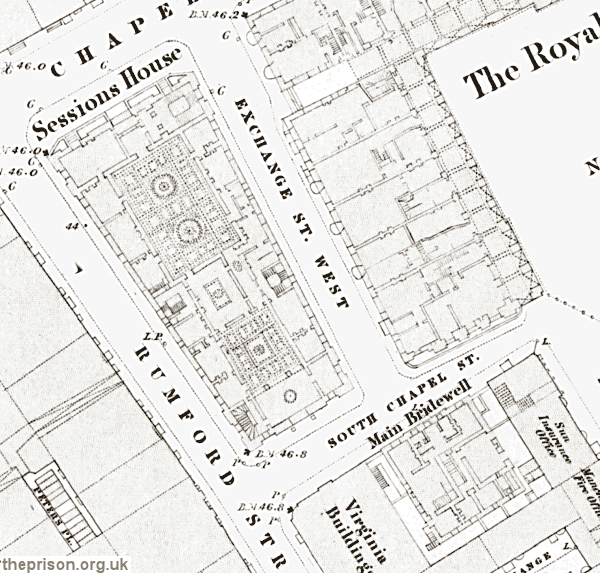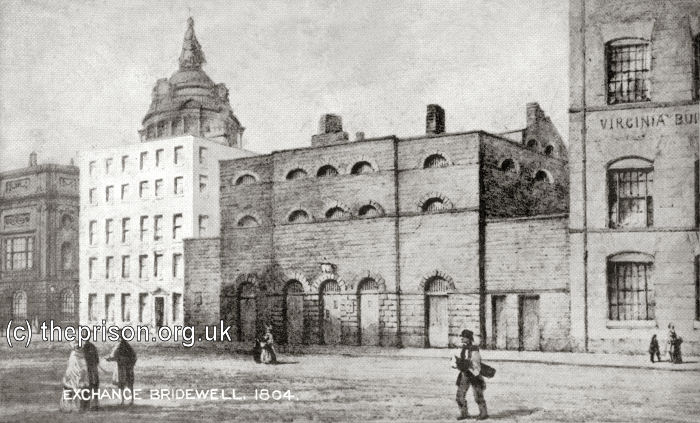Borough Bridewell, Liverpool, Lancashire
A Bridewell, or House of Correction, once existed existed at the old Liverpool Castle site, which stood at the top of present-day Lord Street. It was described in 1812 by James Neild:
The ancient Bridewell was formerly a Magazine, belonging to the Old Castle, and consisted of two cells, one of them 12 feet by 7 feet 6, the other 18 feet by 12; both eight steps under ground, and damp; lighted and ventilated by one iron-barred and grated window in each, with fire-places. Also two rooms above stairs, the one 18 feet by 10, the other 10 feet by 9; and two other cells, totally dark, of only 5 feet by 3 each, and 6 feet high! No straw, or other bedding whatsoever, was allowed. No employment provided. No court-yard. No water accessible to the Prisoners; and the Corporation only allowed them firing. In short, it laboured not merely under the infirmities of deserted age, but had several great and radical defects, which time and skill only could remove.
In 1804, a new Bridewell was opened on Bridewell Street (later renamed South Chapel Street), where Exchange Passage West now runs, to the rear of the Sessions House. The location is shown on the 1847 map below.

Borough Bridewell site, Liverpool, c.1847.

Borough Bridewell, Liverpool, from the north-west, 1804. © Peter Higginbotham
In 1812, James Neild reported on his visits to the new establishment:
Keeper, Robert Walton; now John Hart.
Salary, 57l. 145. and two Turnkeys, at 15s. per week each. Fees, None.
No Chaplain, nor religious attentions.
Surgeon, as wanted, sent from the Dispensary.
Number of Prisoners,
1802, Oct. 11th, 28. 1805, Oct. 25th, 8. 1809, Nov. 13th, 13.
Allowance, three-pence each per day.
[The old bridewell was pulled down at my visit in 1805; and the present building, as a place of temporary confinement, having been got ready, was first inhabited 26 Dec. 1804.
This new Bridewell nearly adjoins the Town-Hall, or Sessions House. From the basement story there is a subterraneous passage, through which the Prisoners are conducted, either for examination or trial. It opens by a trap-door into the bar of the Sessions House; and thus the Prisoners are remanded, when necessary, without being exposed to public view. It also prevents occasional crowds, and disorderly conduct, during the removal of the Prisoners.
The front entrance, or first floor, consists of the Porter's Lodge, 21 feet by 14, and 11 feet high. This room has a fire-place, and glazed windows, and is fitted up with chairs and benches for the Turnkey, and Assistant Constables of the night. A lock-up room, intended for disorderly Females, 23 feet by 15, and 11 feet high, with a fire-place, is fitted up with wooden benches, and a sewer attached to it. Here are also two other cells, for Prisoners to be kept separate; each 9 feet by 8, and 10 feet high, fitted up with cast-iron bedsteads; to each of which the Town furnishes straw-in-sacking beds, two blankets, a bolster, and a rug.
The remainder of this floor is occupied by the Keeper.
The basement story before-mentioned, (to which the descent is by 17 steps,) is surrounded by an open area, from which the rooms are ventilated; and consists of one room, 23 feet by 15, and 10 feet high, with a fire-place, and wooden benches. Here are also two sleeping-cells, of the same size, and fitted up like those above described, with a convenient sewer attached. These rooms are set apart for the reception of refractory Prisoners, or those who are under charge for offences of a more serious nature. The stair-cases are of stone; and all the rooms in which Prisoners are confined, are arched with brick, and have flag-stone floors.
The second story, ascended by 32 steps, is appropriated for the reception of Prisoners of a more decent appearance, committed for slight offences; and contains a large room, and two sleeping-cells, of the same dimensions, and fitted up in like manner as the former.
The remainder of this story, also, is occupied by the Keeper, except one room over the Porter's lodge, which is reserved for Prisoners of respectable connections, Should there be more Prisoners than the cells will accommodate, they must sleep in their clothes, upon benches 2 feet wide.
The sexes are separated. Coals and candles are furnished by the Corporation. But here is no allowance for food, which must be purchased by the Prisoners, or supplied them by their friends. The Prison is well accommodated with excellent water, brought in by pipes. No employment is yet provided; nor any room set apart for the sick. The Act for preserving Health, and Clauses against Spirituous Liquors, not hung up.
In 1837, the Inspectors of Prisons reported:
This prison, for the temporary detention of prisoners apprehended by the police and brought from the lock-ups for examination by the magistrates, is situate in Bridewell-street, near the Exchange. It is a substantial building, with basement, and first and second floor. It is faced with rusticated freestone. It contains apartments for the keeper, and cells for inferior and better classes of prisoners.
It is impossible to speak in too high terms of the admirable manner in which this establishment was conducted by the late keeper, now appointed to the same situation in the Borough Gaol. The rooms are thoroughly cleansed daily, and chloride of lime profusely applied throughout the building. Every attention is paid to prisoners either in a state of intoxication or illness, and property in their possession secured and registered. The parish of Liverpool allows l½ lb. of bread to prisoners without food.
The prison appears to have closed in about 1850.
Records
Note: many repositories impose a closure period of up to 100 years for records identifying individuals. Before travelling a long distance, always check that the records you want to consult will be available.
- No individual records identified for this establishment — any information welcome.
- The National Archives, Kew, Richmond, Surrey, TW9 4DU. Has a wide variety of crime and prison records going back to the 1770s, including calendars of prisoners, prison registers and criminal registers.
- Find My Past has digitized many of the National Archives' prison records, including prisoner-of-war records, plus a variety of local records including Manchester, York and Plymouth. More information.
- Prison-related records on
Ancestry UK
include Prison Commission Records, 1770-1951
, and local records from London, Swansea, Gloucesterhire and West Yorkshire. More information.
- The Genealogist also has a number of National Archives' prison records. More information.
Bibliography
- Higginbotham, Peter The Prison Cookbook: A History of the English Prison and its Food (2010, The History Press)
- Brodie, A. Behind Bars - The Hidden Architecture of England's Prisons (2000, English Heritage)
- Brodie, A., Croom, J. & Davies, J.O. English Prisons: An Architectural History (2002, English Heritage)
- Harding, C., Hines, B., Ireland, R., Rawlings, P. Imprisonment in England and Wales (1985, Croom Helm)
- McConville, Sean A History of English Prison Administration: Volume I 1750-1877 (1981, Routledge & Kegan Paul)
- Morris, N. and Rothman, D.G. (eds.) The Oxfod History of the Prison (1997, OUP)
- Pugh R.B. Imprisonment in Medieval England (1968, CUP)
Links
- Prison Oracle - resources those involved in present-day UK prisons.
- GOV.UK - UK Government's information on sentencing, probation and support for families.
Except where indicated, this page () © Peter Higginbotham. Contents may not be reproduced without permission.



